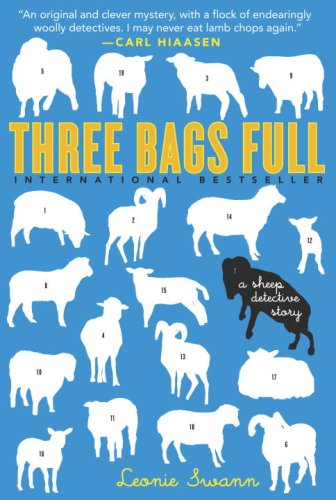Three Bags Full, by Leonie Swann
Jul 26
2007

The set-up is stock casual mystery: in a rural Irish town, a friendly, reclusive shepherd is found dead in his pasture with a spade in his stomach. Everyone in the town had a reason to not only want him dead, but also to fear his death. None of the locals, including the police, care to investigate. Instead, the mystery is left to be solved by a set of lovable amateurs—the shepherd’s abandoned flock.
The nineteen sheep introduced in Leonie Swann's Three Bags Full are charming guides to the world of small-town Ireland. Their names are helpfully listed on the back of the book in order of appearance and sketch out both the book’s tone and its only trick. The sole black sheep is named Othello, the mature inquisitive ewe is named Miss Maple, and the individualist explorer is named Melmoth*. Ms. Swann guides us, her audience, and these archetypal sheep into a world re-imagined with feigned ignorance. (One suspects she might have replaced the sheep with bright children, if society found it acceptable to leave children unattended in a barn for days at a time.)
In the world of Swann's smart-children-y sheep, the smartest sheep is the sheep that chooses not to enter the Cleverest Sheep Contest (because only a fool would forgo the wonderful summer forage and spend the day indoors), the village priest is clearly God, since he lives in God’s house, and seven is an ancient and deservedly revered age. Ideas like these provide the reader with a nice chuckle, but most of Swann's more high-brow efforts fail. To scare off a bad shepherd the flock cooks up a plan to feign a serious disease. Which one? Why Creutzfeldt-Jakob Disease, of course! (Swann offers no explanation of this in the text--it's the sheep equivalent of Mad Cow, commonly called "Scrapies**".) Moving from science to literature, she obscures her flashbacks with enough direct sensory descriptions to make James Joyce proud. Unfortunately, a whimsical mystery is no place for impressionist prose, nor for the repetitive dream sequences that pop up every five chapters. During such literary gimmicks all pretense at sheepiness is set aside: sheep see in color, have depth perception, understand English (but not Gaelic), and dream mostly about people.
By the midpoint of Swann's novel, the initial cleverness wears off, leaving to reader to watch the plot advance like a pocket watch in a glass case. Still, I wanted this book to work, I wanted to be entertained, I wanted to like a sunny mystery about lovable sheep... and if one claps hard enough for Three Bags Full, the plot is just strong enough to allow you to overlook its faults.
*Melmoth The Wanderer is a 1820 gothic novel by Charles Robert Maturin, a great-uncle of Oscar Wilde.
**Wikipedia informs us that there was an X-Files episode about Scrapies, in case you’d like to know more about it. Apparently, there’s this town full of cannibals who eat their victims’ brains, and one of the brains has Scrapies… and we’ll go ahead and stop there.
The nineteen sheep introduced in Leonie Swann's Three Bags Full are charming guides to the world of small-town Ireland. Their names are helpfully listed on the back of the book in order of appearance and sketch out both the book’s tone and its only trick. The sole black sheep is named Othello, the mature inquisitive ewe is named Miss Maple, and the individualist explorer is named Melmoth*. Ms. Swann guides us, her audience, and these archetypal sheep into a world re-imagined with feigned ignorance. (One suspects she might have replaced the sheep with bright children, if society found it acceptable to leave children unattended in a barn for days at a time.)
In the world of Swann's smart-children-y sheep, the smartest sheep is the sheep that chooses not to enter the Cleverest Sheep Contest (because only a fool would forgo the wonderful summer forage and spend the day indoors), the village priest is clearly God, since he lives in God’s house, and seven is an ancient and deservedly revered age. Ideas like these provide the reader with a nice chuckle, but most of Swann's more high-brow efforts fail. To scare off a bad shepherd the flock cooks up a plan to feign a serious disease. Which one? Why Creutzfeldt-Jakob Disease, of course! (Swann offers no explanation of this in the text--it's the sheep equivalent of Mad Cow, commonly called "Scrapies**".) Moving from science to literature, she obscures her flashbacks with enough direct sensory descriptions to make James Joyce proud. Unfortunately, a whimsical mystery is no place for impressionist prose, nor for the repetitive dream sequences that pop up every five chapters. During such literary gimmicks all pretense at sheepiness is set aside: sheep see in color, have depth perception, understand English (but not Gaelic), and dream mostly about people.
By the midpoint of Swann's novel, the initial cleverness wears off, leaving to reader to watch the plot advance like a pocket watch in a glass case. Still, I wanted this book to work, I wanted to be entertained, I wanted to like a sunny mystery about lovable sheep... and if one claps hard enough for Three Bags Full, the plot is just strong enough to allow you to overlook its faults.
*Melmoth The Wanderer is a 1820 gothic novel by Charles Robert Maturin, a great-uncle of Oscar Wilde.
**Wikipedia informs us that there was an X-Files episode about Scrapies, in case you’d like to know more about it. Apparently, there’s this town full of cannibals who eat their victims’ brains, and one of the brains has Scrapies… and we’ll go ahead and stop there.
Posted by: kganey, Last edit by: Julianka
No new comments are allowed on this post.
Comments
No comments yet. Be the first!